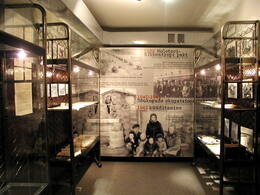Memories of the KGB cells in Tartu
Ülo Raidma, a member of the student resistance organization Blue-Black-White, reminisces about his time spent in the cells.
Ülo Raidma, a member of the student resistance group Blue-Black-White, recalls his time in the cells.
"Reporting to the superior upstairs was quick and sentence was passed even quicker: 10 days in the cold and nine days in the regular cells. Which is to say 10 days in solitary, wearing nothing but rags. For food you were given a slice of bread and a mug of tea once a day, a bowl of soup once every three days. The tall b*st*rd of a prison guard decided to take the stool for himself, so I had to sit half-naked on the cold concrete floor for a whole week in a cell that was less than a metre long and barely over half a metre wide. And as if that wasn't enough, the toilet bucket, which was 30 cm across, took up a lot of space. Its lid was reminiscent of the budenovka [broadcloth helmet - Ed.] worn by Russian soldiers in the 1940s. I was lucky to be wearing a pair of socks. By the first evening I’d already come up with three different positions. The first one was standing up and thinking of nothing. The second was sitting in the foetal position next to the bucket and trying not to think of anything. The third was resting on the back of my neck, legs stretched up high against the wall and trying not to think about the cold... On the sixth or seventh day I noticed my fingers were swollen. I’d heard of malnutrition-related swelling before. I guess I’d progressed that far."
Manuscript source. Tartu City History Museums.
Related topics
Related objects
KGB Cells Museum
This museum is situated on the corner of Riia and Pepleri streets in Tartu.
It is a branch of Tartu City Museum. The museum is located in the infamous grey building on Riiamägi Hill that the KGB used as their base of operations in Tartu during the 1940s and 1950s. The basement here was used as a pre-trial detention centre for political detainees. Now, many years later, it is open to visitors. Some of the cells (including those used for solitary confinement) and part of the corridor have been restored to their original appearance. The exhibition in its former jail cells provides an overview of World War II, the post-war anti-Soviet resistance in Estonia, the crimes committed by the communist regime and the conditions in the detention centre. The idea of opening the museum came from members of a former underground student resistance group in Tartu called Blue-Black-White, who discovered upon visiting their former cells that the basement had been abandoned and that it would not be very difficult to restore the former look of the jail. The museum was officially opened on 12 October 2001.





